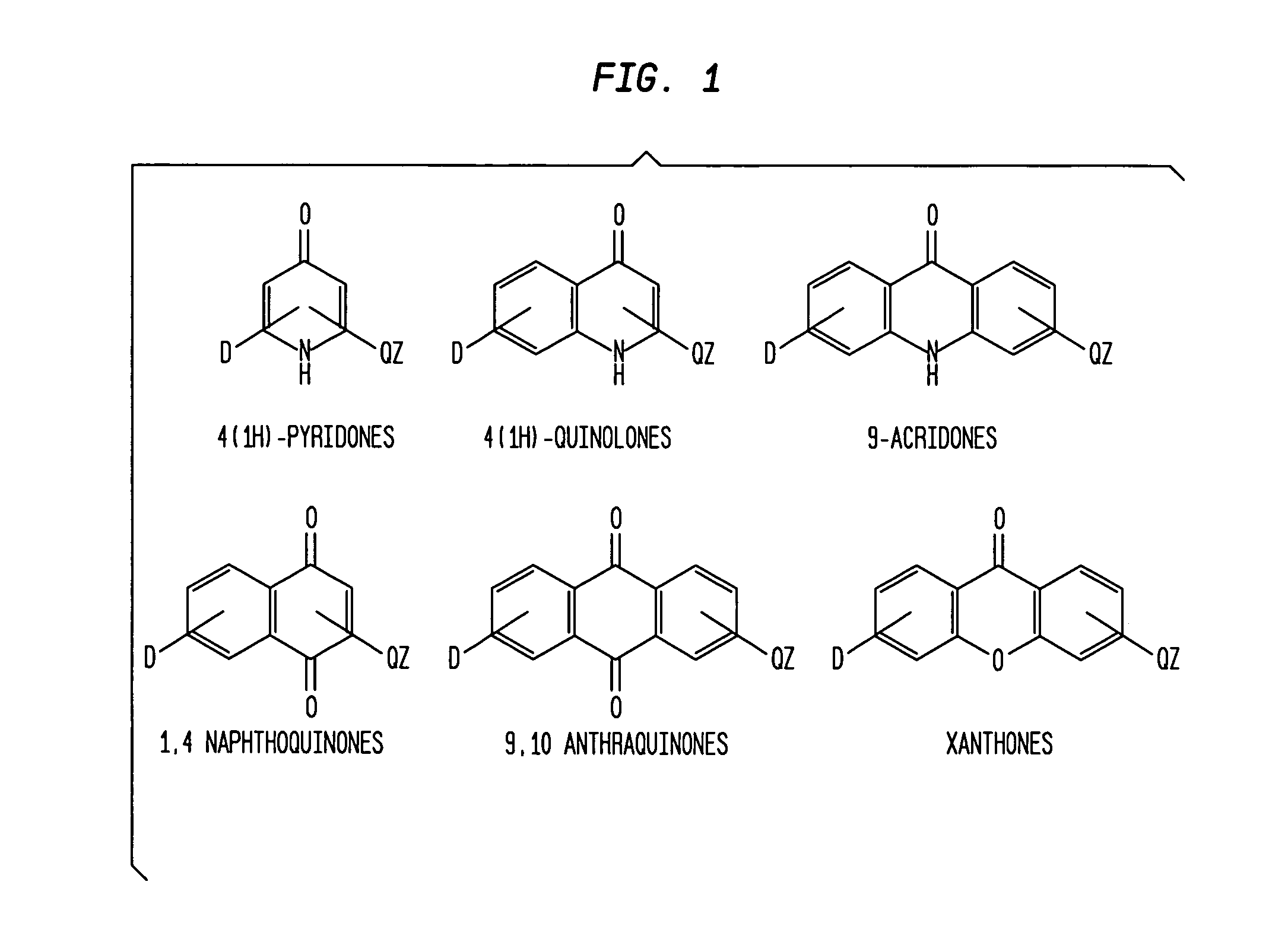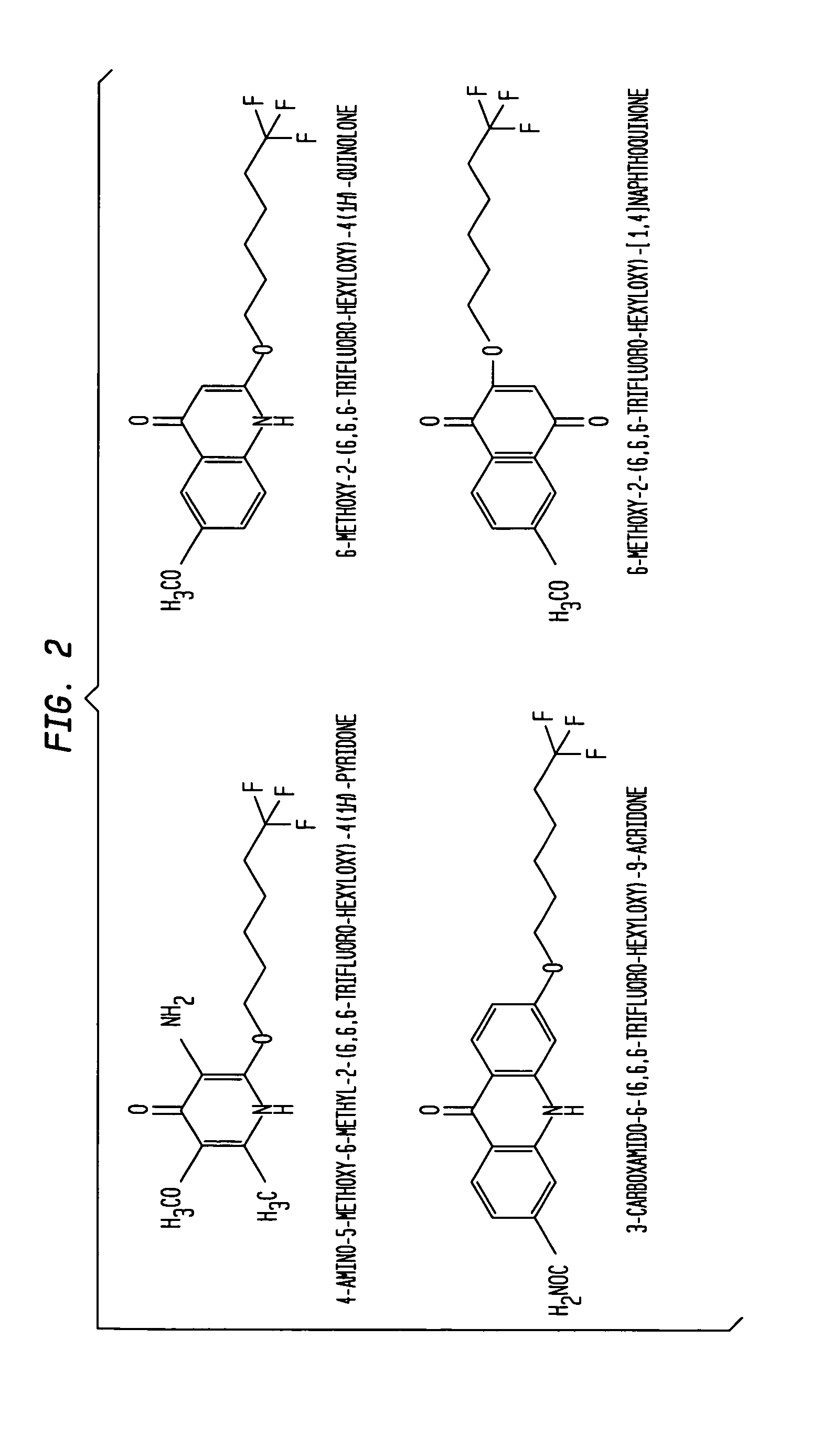Aromatic ketones and uses thereof
a technology of ketones and ketones, which is applied in the direction of nitro compound active ingredients, heterocyclic compound active ingredients, biocide, etc., can solve the problems of malaria, sleep disturbances, and a worsening global health problem, so as to improve the antimalarial potency
- Summary
- Abstract
- Description
- Claims
- Application Information
AI Technical Summary
Benefits of technology
Problems solved by technology
Method used
Image
Examples
example 1
Synthesis of 2-(5,5,5-trifluoropentyloxy)-1,4-naphthoquinone
[0101]The present example demonstrates a method by which the compounds of the present invention may be synthesized. One unique structural feature, among others, of the pharmacophore presented is the presence of a long alkyl or alkoxy side chain bearing one or more fluorine atoms on the terminal carbon atom(s).
[0102]For preparation of 2-(5,5,5-trifluoropentyloxy)-1,4-naphthoquinone: 2-hydroxy-naphthoquinone (1.36 g), 5,5,5-trifluoropentanol (1.30 g), benzene (50 ml) and 10 ml of concentrated hydrochloric acid were heated to boiling for 24 hours. A color change from brick-red to orange occurred. Upon cooling, 2-hydroxy-naphthoquinone crystallized out. The filtrate was evaporated, giving 330 mg of a crystalline residue. It appeared to be a 1:1-complex of 2-OH— and 2-O(CH2)4CF3)-1,4-naphthoquinone. A sample was decomposed in aqueous KOH, and the turbid mixture was extracted with ethyl acetate, the extract shaken 3 times with an...
example 2
Synthesis of 3-(6,6,6-trifluorohexyloxy)-6-hydroxyxanthone
[0103]To 3,6-dihydroxy-xanthone (0.58 g, 1 equivalent) is added 10 ml of ethanol, then 117 mg of KOH 0.8 equivalents), followed by 0.58 g of CF3(CH2)5Br (1 equivalent); after two hours of boiling this mixture, the pH had dropped to the acidic range, and another 100 mg of KOH was added and heating continued overnight. The cooled mixture was diluted with water (50 ml) and extracted with ethyl acetate (3×50 ml), the combined extracts washed with 5 ml of water and brought to dryness. Separation of the 3-component mixture was achieved by chromatography (100 g of silica gel, column diameter 5 cm) with solvents of increasing polarity: Solvents used: ethyl acetate (A), hexane (isomeric mixture) (B), ethanol (C)
[0104]
Volume ratioA:B:C:VolumeEffect1.:1:10:0600 mlno elution2.:2:3:0300 mlCompound I3.:5:9:1650 mlCompound II
The third component, the starting dihydroxyxanthone, was not eluted.
Compound I=3,6-bis-(6,6,6-trifluorohexyloxy)-xant...
example 3
Preparation of a compound of the “D-n-QZ” formulation wherein the 0 bridging atom is a methylene group: 2-Methyl-3-(11,11,11-trifluoro-undecyl)-7-methoxyauinolone
[0105]This method utilizes the “Konrad-Limpach reaction”, which consists of condensing a substituted (position 2) acetoacetic ester with an aniline, providing a 2-alkyl-3-phenylamino crotonic ester (alternatively formulated as a Schiff base) followed by ring-closure in a high-boiling solvent (Dowtherm A, boiling (atm. p) at about 250° C.). An exemplary reaction is presented below.
[0106]Ethyl 2-(11,11,11-trifluoro-undecyl)-acetoacetate is obtained by heating at reflux temperature for 20 hours in 75 ml ethanol, the sodium derivative of ethyl acetoacetate (from 1.60 g ester+0.28 g of Na, first dissolved in ethanol), and 3.45 g of CF3(CH2)10Br. After this period, the alcohol was evaporated and then water (50 ml) was added to the residue and the product extracted with ethyl acetate (1×40, 1×30 ml), the extracts combined and the ...
PUM
| Property | Measurement | Unit |
|---|---|---|
| Electric dipole moment | aaaaa | aaaaa |
| Volume | aaaaa | aaaaa |
| Volume | aaaaa | aaaaa |
Abstract
Description
Claims
Application Information
 Login to View More
Login to View More - R&D
- Intellectual Property
- Life Sciences
- Materials
- Tech Scout
- Unparalleled Data Quality
- Higher Quality Content
- 60% Fewer Hallucinations
Browse by: Latest US Patents, China's latest patents, Technical Efficacy Thesaurus, Application Domain, Technology Topic, Popular Technical Reports.
© 2025 PatSnap. All rights reserved.Legal|Privacy policy|Modern Slavery Act Transparency Statement|Sitemap|About US| Contact US: help@patsnap.com



